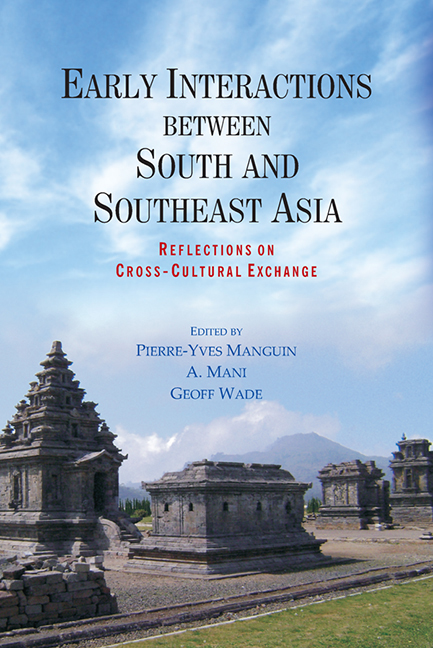Book contents
- Frontmatter
- Contents
- FOREWORD
- Preface
- Introduction
- PART I New Archaeological Evidence from South Asia and Southeast Asia
- PART II Localisation in Southeast Asia
- 11 Tamil Merchants and the Hindu-Buddhist Diaspora in Early Southeast Asia
- 12 The Spread of Sanskrit in Southeast Asia
- 13 The Early Inscriptions of Indonesia and the Problem of the Sanskrit Cosmopolis
- 14 Indian Architecture in the ‘Sanskrit Cosmopolis’: The Temples of the Dieng Plateau
- 15 The Importance of Gupta-period Sculpture in Southeast Asian Art History
- 16 Individuals under the Glaze: Local Transformations of Indianisation in the Decorative Lintels of Angkor
- 17 Early Musical Exchange between India and Southeast Asia
- 18 Buddhism and the Circulation of Ritual in Early Peninsular Southeast Asia
- 19 Early Buddhism in Myanmar: Ye Dhammā Inscriptions from Arakan
- 20 Hindu Deities in Southern Vietnam: Images on Small Archaeological Artefacts
- 21 ‘The Depositing of the Embryo’ – Temple Consecration Rituals in the Hindu Tradition of South and Southeast Asia: A Study of the Textual and Archaeological Evidence
- 22 Localisation of Indian Infl uences as Refl ected in the Laotian Versions of the Ramayana
- 23 Broken Threads: Contested Histories of Brahminism in Cambodia and Thailand and the Construction of Ritual Authority
- LIST OF CONTRIBUTORS
- INDEX
16 - Individuals under the Glaze: Local Transformations of Indianisation in the Decorative Lintels of Angkor
from PART II - Localisation in Southeast Asia
Published online by Cambridge University Press: 21 October 2015
- Frontmatter
- Contents
- FOREWORD
- Preface
- Introduction
- PART I New Archaeological Evidence from South Asia and Southeast Asia
- PART II Localisation in Southeast Asia
- 11 Tamil Merchants and the Hindu-Buddhist Diaspora in Early Southeast Asia
- 12 The Spread of Sanskrit in Southeast Asia
- 13 The Early Inscriptions of Indonesia and the Problem of the Sanskrit Cosmopolis
- 14 Indian Architecture in the ‘Sanskrit Cosmopolis’: The Temples of the Dieng Plateau
- 15 The Importance of Gupta-period Sculpture in Southeast Asian Art History
- 16 Individuals under the Glaze: Local Transformations of Indianisation in the Decorative Lintels of Angkor
- 17 Early Musical Exchange between India and Southeast Asia
- 18 Buddhism and the Circulation of Ritual in Early Peninsular Southeast Asia
- 19 Early Buddhism in Myanmar: Ye Dhammā Inscriptions from Arakan
- 20 Hindu Deities in Southern Vietnam: Images on Small Archaeological Artefacts
- 21 ‘The Depositing of the Embryo’ – Temple Consecration Rituals in the Hindu Tradition of South and Southeast Asia: A Study of the Textual and Archaeological Evidence
- 22 Localisation of Indian Infl uences as Refl ected in the Laotian Versions of the Ramayana
- 23 Broken Threads: Contested Histories of Brahminism in Cambodia and Thailand and the Construction of Ritual Authority
- LIST OF CONTRIBUTORS
- INDEX
Summary
When medieval Khmer artists chiselled into the sandstone lintel, components of the lintel design were entirely of their own making. The sovereign, project superintendent, and team supervisor all possessed the requisite power to tell artisans what to carve, but idiosyncratic differences in every work indicate that the majority of the specific decision-making was left to the artist. Control over every small detail of artistic creation would have been difficult to realise and administer. The patrons of the sculptural and architectural commissions apparently trusted the ability of the artists to produce work with the requisite symbolic and aesthetic power. Most of the time, artists selected and rendered iconography from a repertoire of forms known to them from training and tradition. But the medieval Khmer artistic tradition also facilitated innovation and difference between objects. The most important decorative lintels, situated on the most visible prasat and façades were often a chance for artists to demonstrate their creativity and skill by distinguishing their work. Even lintels that were carved at modest village shrines possess eccentricities in iconography and form. The recognition of the multitude differences in decorative lintels opens the way for a more exuberant and humane perspective of artistic change in the Angkorian world. When variation in the different components of artistic and material culture are assessed, change can be perceived as dynamic and constant, where medieval Khmer artists actively make novel associations of iconography and form.
The monuments of Cambodia abound with Indian derived motifs and deities. The medieval inscriptions likewise reveal a profound familiarity with the corpus of Indian Sanskrit literature. The substantial influence of Indian cultures on Southeast Asia, known as ‘Indianisation’ has framed much research on the Angkorian world. In order to understand medieval Khmer culture, repeated reference has been made to Indian meanings and texts which may have had little association with specific Southeast Asian contexts. This has created a problematic and uneasy dichotomy where the indigenous elements of medieval Khmer culture were determined by subtracting the correspondences with India. There is a body of contemporary scholarship, however, that seeks to emphasise Southeast Asian initiative through recognition of detail in the historical process.
- Type
- Chapter
- Information
- Early Interactions between South and Southeast AsiaReflections on Cross-Cultural Exchange, pp. 333 - 346Publisher: ISEAS–Yusof Ishak InstitutePrint publication year: 2011



